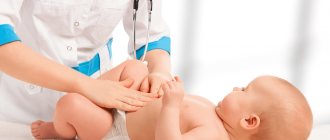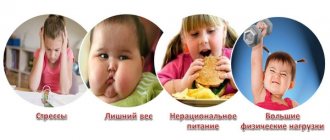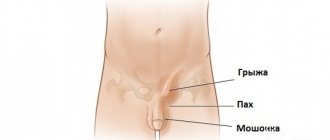Dyspepsia is a digestive disorder of a functional or organic nature. It is non-infectious and occurs in acute or chronic form. Moreover, this phenomenon is not associated with an abnormal structure of the stomach or gastrointestinal tract. Dyspepsia in children is expressed as vomiting, nausea, constipation and diarrhea. It can be caused by an unbalanced diet. Simple dyspepsia can become complicated and become toxic. The toxic phase of the disease is very dangerous for children and can even lead to the death of the child if medical assistance is not provided in a timely manner. Dyspepsia in children occurs in both infants and older children.
Causes of dyspepsia in children
The disease is often diagnosed in children under three years of age. At this age, the causes of dyspepsia in children are the consumption of foods that do not correspond to the child’s age (fatty foods, foods that are poorly digested). Still other unfavorable factors are overfeeding, monotonous, non-nutritious food, changing the diet of a nursing mother, a sudden transfer to artificial nutrition after breastfeeding, and the introduction of complementary foods. In infants and children under three years of age, dyspepsia is explained mainly as follows. The baby is offered food that his body, due to his age, cannot digest and assimilate. If the food offered to a child is unbalanced and does not correspond to the capabilities of his digestive system, then the following situation arises. Digestive processes, metabolism, growth processes are disrupted, and enzyme systems are imbalanced. These destructive phenomena can provoke diseases such as rickets, developmental delays, and anemia.
The causes of dyspepsia in older children are non-compliance with food intake, consumption of sweet soda, fast food and other junk food. Stressful situations can also affect younger and older children. The disease can become toxic. It is provoked by intestinal infections, poor nutrition, dry food, not according to the regime. Also, toxic dyspepsia can be caused by ordinary dyspepsia if it is complicated.
Children are more susceptible to developing pathology:
- born prematurely, premature;
- with perinatal CNS disorders;
- who have malnutrition, rickets, hypovitaminosis, allergic reactions, etc.
But it is also possible that you cannot do without medication.
What medications are suitable for children then?
Let me remind you that, based on the definition of reflux disease, doctors face two tasks:
- remove symptoms that bother your child
- achieve healing of damaged mucous membranes
The most effective group are drugs that limit the secretion of hydrochloric acid, the most aggressive substance of gastric juice.
They do not have the task of completely removing acid - it is needed for processing food.
It is necessary to reduce the amount of acid so that there are as few episodes of increased acidity in the esophagus as possible.
There we will give the mucous membranes of the esophagus the opportunity to gradually recover and continue to better protect themselves on their own.
H2-histamine blockers were the first to be used to suppress acidity - of these, ranitidine and famotidine are still used.
But quite quickly they were replaced and almost replaced by blockers (aka inhibitors) of the proton pump (PPI) - omeprazole, panthorazole, lansoprazole, rabeprazole, esomeprazole and dexlansoprazole.
There are few studies comparing the effectiveness of H2-histamine blockers and PPIs in children, but there is much more extensive experience comparing them in adults with GERD.
This experience suggests that PPI is still better.
Nevertheless, in many Western countries, H2-histamine blockers are still actively used in children.
Perhaps due to the extensive experience of doctors or perhaps for economic reasons.
Russian recommendations on GERD in children directly state that H2-histamine blockers have less effectiveness, an unfavorable pharmacotherapeutic profile, and also a high risk of developing tachyphylaxis (addiction), therefore, their use in children as antisecretory therapy is not recommended.
Currently, proton pump inhibitors are the main drugs for the treatment of reflux in children and adults.
Read more about proton pump inhibitors.
In Russia, esomeprazole (Nexium) is approved from 1 year of age in a special pediatric form; in the USA it is approved for special indications for children under one year of age.
Not all drugs used in adults are approved for use in children.
Some do not have a child's uniform.
Some have not yet received permits in Russia.
However, from the age of 12, the choice of drugs is already quite large.
Proton pump inhibitors have proven to be effective drugs with excellent tolerability.
But you always want something cooler.
Vonoprazan , an antisecretory agent from a completely new group, has recently appeared in some countries
Vonoprazan is better at controlling acidity in the stomach and esophagus than PPIs.
It has not yet been registered in Russia, and is not yet approved for children anywhere.
But who stops you from dreaming...
Symptoms of dyspepsia in children, when to see a doctor
Dyspepsia symptoms and treatment in children are the responsibility of specialists. You should not self-medicate. You should be alert to the following warning signs that may indicate the presence of pathology:
- restless behavior of the child;
- decreased appetite;
- frequent bowel movements, loose stools;
- bloating;
- vomit;
- pain in the gastrointestinal tract.
This disease can cause thrush, stomatitis, and diaper rash. If the baby is very weak, toxic dyspepsia may occur. It is characterized by a strong increase in body temperature, vomiting, and diarrhea. The child may shiver and occasionally have convulsions. Complications of the disease are fraught with severe dehydration, weight loss, and tissue turgor decreases. At the same time, the retraction of the large fontanel is evident. With such symptoms, you need to urgently go to the clinic, since complications sometimes lead to impaired consciousness, coma and death.
The following signs are typical for older children: there is constant pain in the gastrointestinal tract after eating, the child feels full as soon as he starts eating. The following symptoms are also possible: nausea, a feeling of heaviness in the stomach, belching, a burning sensation in the chest. Older children also experienced dizziness, severe sweating, and problems with bowel movements, when constipation was replaced by diarrhea.
If you have these signs, you should visit your pediatrician as soon as possible. If you have symptoms of the toxic stage of the disease, it is better to call an ambulance.
Prohibited Products
People cannot tolerate some foods individually.
For the inflamed gastric mucosa, foods that cause fermentation, bloating, increased gas formation, or high fiber content are not recommended:
- legumes,
- nuts,
- mushrooms,
- fresh fruits (grapes, plums) and juices from them,
- vegetables (cucumbers, herbs, beets),
- fatty meats and fish,
- high fat dairy products,
- porridge with whole milk,
- rich broths,
- rich pastries,
- confectionery.
- smoked meats,
- fried foods,
- canned food,
- spicy and pickled dishes.
A complete ban is imposed on the consumption of alcohol and carbonated drinks.
Treatment of dyspepsia in children
Here it is very important to identify the factor that provoked the disease. The following methods are usually used for treatment:
- correction with the help of doctors of the diet of a small patient;
- Enzymes are prescribed to improve digestion, sorbents, painkillers, prokinetics and probiotics. If the disease is severely advanced, then parenteral hydration therapy is used, plus anti-seizure, cardiovascular and fever medications. The acute form of the pathology is treated with antibacterial drugs.
Let us describe the treatment of dyspepsia in children in a little more detail. When an exacerbation phase occurs, the following is prescribed:
- water-tea break;
- reducing the load on the digestive tract with the introduction of fluid (glucose and salt fluids) to replenish its loss due to diarrhea and vomiting.
As soon as the child gets better, enzymes are prescribed to normalize the absorption of food, sorbent preparations to remove intermediate toxins, and medications to correct the microbial flora. Antibiotics and intestinal antiseptics are not prescribed in this case. In case of complications that can cause significant harm to the child, that is, with toxic dyspepsia, hospitalization is sometimes prescribed and therapeutic measures of the same nature are organized, plus the use of antibiotics. As soon as the baby’s health is no longer in danger, treatment is prescribed in the form of a long-term diet with a gradual expansion of the range of food consumed. Enzymes are often prescribed for a long period of time, and such drugs are discontinued gradually and smoothly.
Diagnosis of the disorder
Children with dyspepsia syndrome should be examined by a pediatrician or pediatric gastroenterologist. First, anamnesis is collected, a clinical examination is performed, and then laboratory and instrumental diagnostics are prescribed. First, you need to determine whether indigestion is organic or functional in nature.
For this purpose, ultrasound of the abdominal organs, x-ray of the stomach, endoscopy (endoscopic examination of the esophagus, stomach and duodenum) are prescribed. Laboratory tests are carried out: stool examination (to detect Helicobacter pylori infection, which often causes gastritis), blood and urine (to detect the level of pancreatic enzymes).
Additionally, biochemical liver tests, bacteriological culture of stool, and tests to detect helminth eggs may be prescribed. Differential diagnosis is carried out between functional dyspepsia and enzymopathies (lactase deficiency, celiac disease), intestinal dysbiosis, helminthiasis, and intestinal infection.
Prevention of dyspepsia in children
These are the preventive methods. You need to adhere to the diet that the doctor prescribes to you at the clinic. If medications are prescribed, they must be taken in strict accordance with the recommendations of a specialist. Next, you will need to provide your child with a nutritious, balanced diet, taking into account his age category. Food should be rich in nutrients, vitamins and microelements. The food needs to be of high quality. You should not offer your child or teenager fatty foods or those that are poorly absorbed by the body. Fast food, carbonated water, and fatty foods are prohibited.
Eating for an upset stomach
The main requirement for products included in the menu for this pathology is the ability to envelop its walls. Various porridges, jelly and puree soups have these properties. Buckwheat porridge and rice cooked in water, without adding salt or butter, meet all the requirements. An excellent dietary dish is steamed soufflé made from pureed lean beef or chicken.
A breakfast of pureed cottage cheese and steamed omelet, supplemented with crackers from homemade white bread, will have a positive effect on the stomach. To restore the microflora of the stomach and normal digestion, you need a full set of lacto- and bifidobacteria. To replenish the arsenal of beneficial bacteria, take fermented milk products without dyes and preservatives with low fat content.
How to recognize pneumonia
Pneumonia is usually accompanied by several typical symptoms:
• severe cough with sputum;
• chest pain;
• heat;
• weakness.
Symptoms of the disease may intensify gradually, or may appear suddenly – within one or two days. If there is a sharp deterioration in the condition or a prolonged course of the disease, it is necessary to seek medical help.
There are also atypical forms of pneumonia, which are not always accompanied by symptoms typical for pneumonia. Mild symptoms, which make the disease more reminiscent of ARVI, may be accompanied by headaches, muscle pain, and nausea. Due to the smoothness of symptoms, patients usually do not consider their condition dangerous and are in no hurry to see a doctor, and a picture corresponding to pneumonia is diagnosed only after an X-ray or computed tomography.










